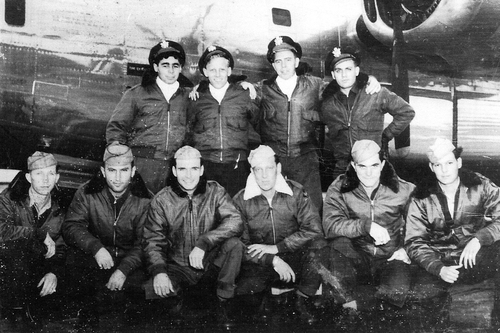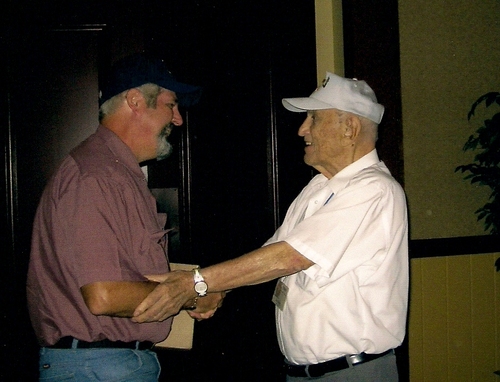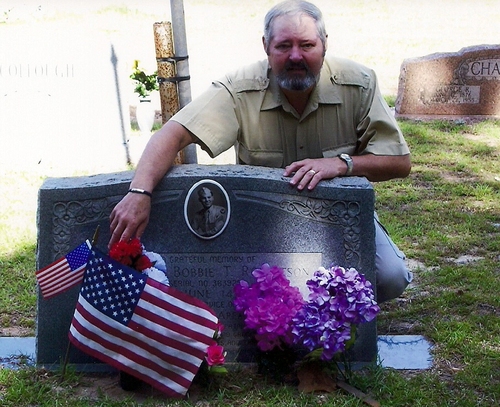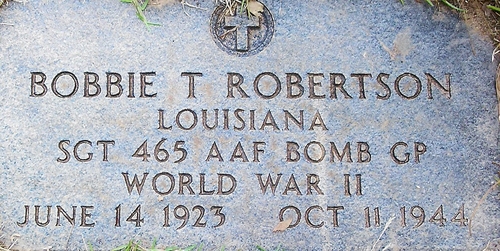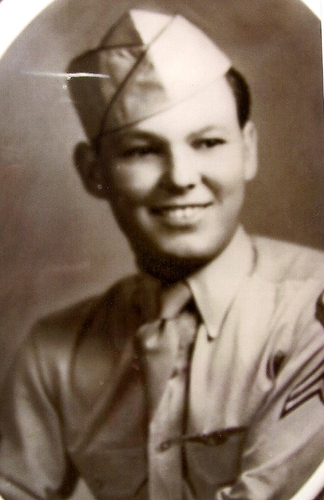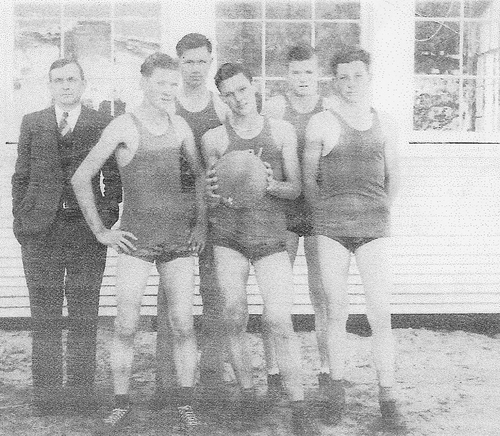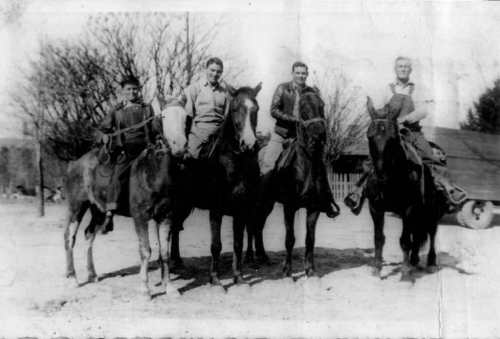.JPG)
By Rickey Robertson
Even though World War II ended 67 years ago in 1945, there are still so many untold stories that need to be told before all the servicemen of this era are gone. An unbelievable World War II story came true for a Sabine Parish family. So as we remember the upcoming Memorial Day in 2012, I wish to share this story. Remember one thing that FREEDOM is not free and it comes at a very high cost. Fly your flag proudly and remember veterans of ALL eras and conflicts each day!
Bobbie Robertson was born in Sabine Parish in the Peason Community on June 14, 1923, to Mr. and Mrs. O.A. Robertson. Like all children born during this time, he lived through the Great Depression. His parents were farmers growing cotton and corn; they had hogs and cattle in the woods, and their income did not provide for luxuries as we know them today.
Bobbie was energetic and well mannered, interested in engines and mechanics, and a young man who liked to pick his guitar and sing the songs of that era. He attended Plainview High School, located between Peason and Hornbeck and graduated in 1942. Bobbie had some odd jobs, even working shortly at Camp Polk. However, in 1943 he enlisted in the Army Air Corps because he was always interested in airplanes. He told his younger brother Bud that he joined the fight so that his little brother would not have to, and that he would always have freedoms that other people around the world did not have.
After basic training, he became a crew member on a B-24 Heavy Bomber. His training included gunnery at Las Vegas, Nevada; crew training was at Mountain Home Army Air Base, Idaho, and finally Keesler Army Air Base in Biloxi Mississippi. He trained to be a crew chief and flight engineer on a B-24 bomber. The demands for more bomber squadrons overseas led to his assignment on the 780th Bombardment Squadron of the 465th Bombardment Group, 55th Bomb Wing, which was attached to the 15th Air Force in Italy. This unit entered combat on May 5, 1944 and served as a strategic bombardment organization until April 1945, as the war was coming to an end.
The missions of the 465th Group were to attack railroad marshaling yards, dock facilities, refineries, oil storage plants, aircraft factories, and other objectives in Italy, France, Germany, Czechoslovakia, Austria, Hungary, and throughout the Balkans. On two different missions when they were bombing marshaling yards and refineries in Austria on July 8, 1944 and steel manufacturing plants in Germany on August 3, 1944, this bomb group bombed all of its targets despite intense anti-aircraft fire and intense fighter opposition. They were awarded the Distinguished Unit Citation for each of these missions.
Bobbie Robertson was a member of this famous group and was on a bombing mission on October 11, 1944 when 22 aircraft were launched and took off to attack Vienna Austria. This group was provided cover by Army P-38 and P-51 fighters. However, over the target, heavy flak was encountered. Two aircraft were shot down. One of these aircraft was the B-24 that Sgt. Bobbie Robertson was flying on. The plane was hit near the bomb bay with flak and began to break up and burn. Other bombers counted from 4 to 9 parachutes leaving this burning aircraft when debriefed back at the home base. As the aircraft was hit, the crew members began bailing out with assistance of Sgt Bobbie Robertson. Seven of the crew members were killed in action and 3 were captured. The last 3 to parachute out survived and were captured by the Germans. The 7 members of the crew killed had been machine gunned in the air as they came down from the sky.
Bobbie's family had always wondered who he served with, where they served, who were his friends, and most of all, what actually happened the day he was killed in 1944. The family received letters from the Army Air Forces but they did not give hardly any information. And on one letter the family was advised not to try to contact the unit or any of the men in the squadron. This was before the day when there were press releases and so many ways to make contact with the men he served with. Unable to obtain any real information the family could just wait and pray.
So Bobbie Robertson, the young boy from Sabine Parish, and like so many other young men who were in the military in World War II, was killed in action on October 11, 1944. For many months he and his crew were listed as missing in action, with all his mail being returned to his family marked "Missing in Action". It was not until hostilities ended and the 3 members of the crew captured by the Germans were released from their POW camp, were the details of the death of the crew brought forth. The 7 dead Americans were buried by the Germans in the area around Vienna Austria. It was not until 1950 that Sgt. Bobbie Robertson's father, O.A. Robertson, got enough money together, and went through the U.S. government and had his son's remains brought back to the U.S. for burial. In 1950 Sgt. Robertson's remains were brought into Many La. by rail. A funeral service was held at Mt. Carmel Baptist Church, and his remains were buried there in the church cemetery. Sgt. Robertson has a very patriotic headstone bearing his military photograph, and it reads that he is in a very long line of patriots who sacrificed their self for their country so that our freedom might continue to grow and prosper.
Bobbie's father and mother passed away and never had any real answers to their son's death. But Bobbie's nephew, Rickey Robertson began to try and find out information. In 1985 he contacted the Personnel Records Section in St. Louis Missouri in an attempt to find any information that might be on file. He was advised that even after 41 years the mission had not been declassified and he could not obtain any information. For nearly 3 years Rickey stayed in contact with the government and was finally able to get the mission declassified in 1988. He was able to obtain missing air crew reports, after action reports, bombing mission reports, and other tidbits of information. But there was no actual person named that could be contacted.
From 1988 until 2005 Rickey could find no further information. But in 2005 he was able to contact Bob Blier, president of the 780th Bomb Squadron Association. Mr. Blier did not know Sgt. Robertson personally but advised Rickey he was eligible to join the organization due to his uncle's service in the 780th. Rickey and his wife Patsy joined and were able to start getting "Flightline" the newsletter of the organization. Even though it only came out intermittently, Rickey scanned the newsletter for any information he could. Stories came out on many of the 780th missions, but never on the October 11, 1944 mission. But in one last attempt, Rickey wrote to Flightline, now being published and edited by Kathy LeComte, also a family member of a 780th veteran and asked any of the surviving members of the squadron if they had any information. About 3 weeks after the Flightline issue came out, Rickey received a letter from Walled Lake, Michigan. He opened the letter, and lo and behold, it was from the last surviving member of the B-24 crew on which Bobbie Robertson was assigned!! Joseph J. Kling had served with Bobbie and was a B-24 nose gunner. He had given Rickey his phone number and Rickey made contact with Joe. It was an emotional talk over the phone with Joe, who had witnessed the B-24 Bobbie Robertson, was on get hit and the crew starting to bail out. Joe advised he had a 780th Bomb Squadron yearbook and that he would send it to Rickey in memory of his uncle and he advised he was 93 years old and did not have any family left and it would keep the story of the crew alive. After several phone calls it was found that the 780th Bomb Squadron would have their 39th reunion in September 2010 in Biloxi, Mississippi where many of the men had trained. Joe and Rickey made plans to attend so that they could meet each other.
Early in the morning of September 15, 2010 Rickey and Patsy headed to Biloxi to attend the reunion. After checking in they headed to the convention area where the 780th reunion was to take place. As Rickey reached for the door an elderly man wearing a 780th Bomb Squadron cap came out the door. Rickey's wife Patsy said, "Rickey it's Joe Kling"! as she saw his name tag . And there was the last surviving member of Bobbie Robertson's crew. A very tearful reunion took place right there!!!
Rickey and Patsy had brought a large display of photographs of historical memorabilia in honor and memory of Bobbie Robertson, along with handouts of World War II information. Joe Kling introduced each World War II veteran to Rickey. Each man and his family opened their arms up to Rickey and Patsy and took them into the family of the 780th Squadron. They were all as excited as Joe Kling in meeting a former comrade's family member. And did they show them some kind of hospitality!!
Rickey and Joe were able to sit down for an interview later in the day and he was able to tell Rickey of his uncle. Joe had joined the B-24 crew Bobbie Robertson was on at Mountain Home Army Air Base in Idaho as the nose gunner. He had lived and had flown with Bobbie and the rest of the crew from that day until he was discharged in 1945. The crew and many other's departed Newport News Virginia in August 1944 and after 28 days in a troop convoy, arrived in Italy on September 1, 1944. They moved into tents at Pantanella Air Base, with the 6 enlisted men living together in a tent and the officers in another. Joe said that the crew was briefed and continued to train before being assigned to a combat mission. On October 11, 1944 they were assigned to their first combat mission. Since they had never flown a combat mission, each crewman was assigned to fly with a different crew on separate B-24's. After being awaken at 3 a.m. for breakfast and the flight briefing the squadron took off to bomb one of the toughest targets, Vienna Austria. Flying at 22 thousand feet the squadron and rest of the bomb group were in range of over 200 German flak guns for nearly 18 minutes. Joe Kling was flying nose gunner in the plane directly behind his friend, Bobbie Robertson. Just after "bomb's away" Bobbie's plane was hit right in the bomb bay area by a burst of flak. Joe Kling, flying 100 feet above the rear of Bobbie's plane, saw the shell burst and the B-24 begin to break up. Joe saw 3 men bail out as the plane began to fall and then he lost sight of it. The tail gunner on Joe's plane saw 4 more men bail out before they lost sight of the stricken plane. Upon arrival Joe and the men in the plane he was flying were debriefed and gave the intelligence officers information on what they saw. Sadly Joe and the other men of Bobbie's original crew made it back to their tent area. Joe told of what a sad day it was to have lost his friend on their very first mission. Several days later the First Sergeant came into their tent and began packing Bobbie's personal items in his footlocker for shipment back to his family, and Joe Kling assisted. Rickey was able to tell Joe that before his grandmother died, he was given Bobbie's footlocker, just as packed in 1944, to keep the story of Bobbie Robertson alive for the family. Ironically, Joe Kling and the rest of Bobbie's original crew flew a total of 35 combat missions and all survived the war. Never knowing that Bobbie's family had never received any personal information about his death they returned home and started a new life. Joe returned to Michigan and was a barber for nearly 75 years. All the other crewmen have now passed away.
The squadron has only 66 men left from all those who were in it in World War II and only 9 were able to attend the reunion. While at the reunion, sadly, the men voted to make this the last reunion of this the 780th Bomb Squadron. At the last banquet on September 16th, the Operations Officer and 3 lieutenants of the newly re-activated 780th Squadron from Eglin Air Force Base attended. When re-activated by the Air Force the unit was not designated as a bomber squadron, but a test squadron. This outfit tests all the munitions used by the Air Force in Iraq and Afghanistan and will continue to uphold the history of its World War II ancestors.
Friday morning September 17, 2010 all the members and their families who had attended began leaving for their homes. Rickey, Patsy, Joe Kling, and Jane MacKenzie had one last breakfast meal together and after handshakes and hugs, each departed their own way. But in meeting Joe Kling, Rickey Robertson had met his uncle's friend, his comrade, and crew-mate and had gotten answers to all the many questions left unanswered since 1944 by his family. With continued plans to keep in touch and possible other visits, Rickey and Joe headed their separate ways, Joe all the way to Michigan and Rickey back to Peason, La. And what a friendship they have. They keep in telephone contact, and hopefully in the summer of 2012 Joe and his friend Jane may come to Louisiana and visit with al of Bobbie Robertson's surviving relatives.
We need to thank the countless numbers of veterans who served in World War II and fought for our country and most of all our freedom. And we need to remember our servicemen who continue to serve and to fight and die for our nation. Our World War II veterans are passing away at an alarming rate. They are a great treasure of our country. Please tell them thanks for their service and get them to tell you their stories. And yes, there are still incredible stories from World War II out there that have never been heard. And ask Rickey and Patsy Robertson. They can now tell you they have met and associated with members of what is truly "The Greatest Generation".
